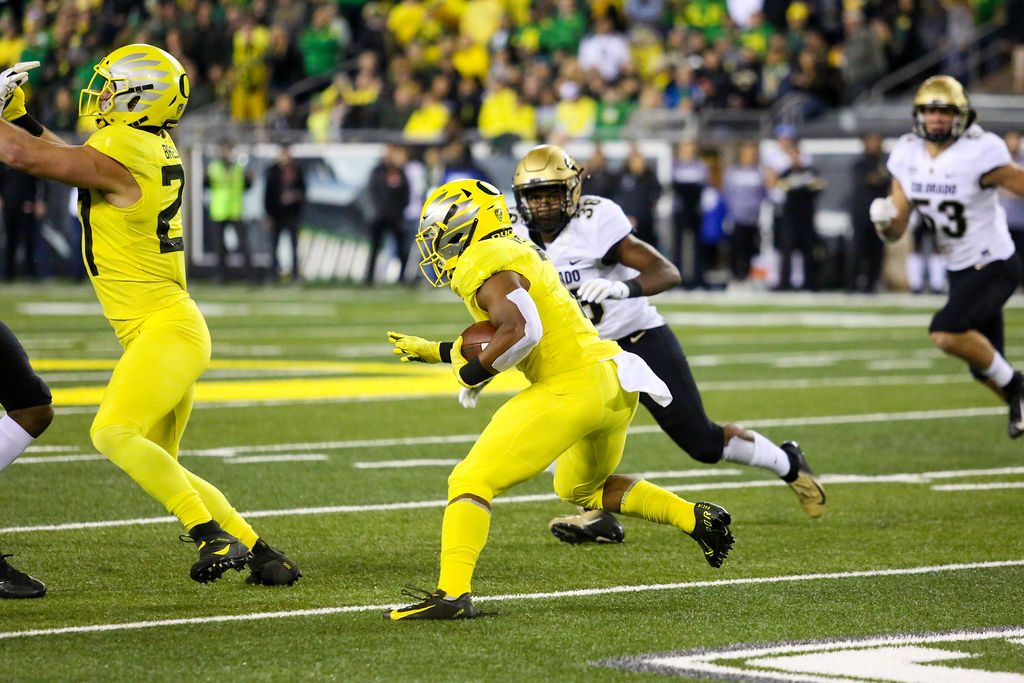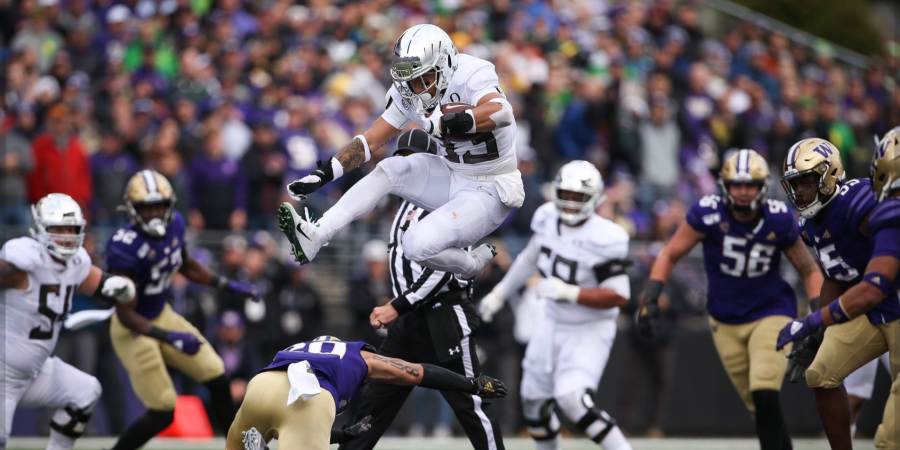Going as far back as before the 2018 season, many have wondered (ourselves included) who would step up and assume the title of “lead back” in the Oregon offense in a post-Royce Freeman world.
Tony Brooks-James was initially perceived to be the heir apparent to the record-setting Freeman, but as the season got underway, that proved to really only be a title by default. Instead, then-freshmen CJ Verdell and Travis Dye assumed the bulk of the work on the ground by the time Pac-12 play started, as the duo would go on to lead the Ducks in rushing combining for 1,757 yards and 14 touchdowns in a resurgent year for Oregon.
Entering this season, Verdell and Dye were more or less expected to be virtual co-starters at the position in what was anticipated to be a season in which the Ducks’ rushing attack took step forward behind the most experienced and perhaps the most talented offensive line in the country. That hasn’t quite materialized, as a Verdell-Dye timeshare has produced modest results, particularly over the first month of the season which saw Oregon rush for less than 100 yards against two Power 5 opponents (90 vs. Auburn, 61 at Stanford).
However, since re-dedicating themselves to finding answers in the run game during the bye week prior to the Cal game, the Ducks have seemingly found their rhythm on the ground. In their last three games, Oregon has rushed for 190 yards, 252 yards, and 154 yards, respectively, as each game has featured a different leading rusher. Against the Bears, Dye paced the Ducks with 81 yards on the ground. Against Colorado, Verdell was the leading man with 171 yards, the most by an Oregon rusher this season. This past weekend at Washington, redshirt sophomore Cyrus Habibi-Likio was the bell cow, rushing for 81 yards – all in the second half – to help erase the Ducks’ 14-point second half deficit.

When asked how he has gone about determining the pecking order in the backfield, Ducks head coach Mario Cristobal has plainly stated that he has typically deferred to whichever player has had the “hot hand.” Depending on the scenario, that would feel like a relatively hopeless approach to establishing a reliable running game from week to week. But in Oregon’s case, with all three running backs demonstrating an ability to “heat up” at any given time, it might actually be the approach that bears the most fruit.
With the exception of the Montana game, Verdell has been the back that has gotten the first crack at kickstarting momentum on the ground. In fact, this season, Verdell has enjoyed a good deal of success in a lead-off role, gaining 204 of his team-leading 496 yards in the first quarter. From there, Dye has often been the first player off the bench to spell Verdell, offering fresh legs and a quick burst to keep opposing defenses on their heels. Though fumbles have perhaps limited Dye’s contributions in recent weeks, the sophomore is a player Cristobal and running backs coach Jim Mastro have continued to count on to provide the rushing attack with a lift.
Both players, however, may be taking more of a complementary role to Habibi-Likio. The redshirt sophomore from the Bay Area ranks third on the team in rushing with 205 yards, but has rushed for single-game career-highs in each of the previous three games, appearing determined to carve out a larger role for himself beyond the goal line and short-yardage carries he has often received over the course of his burgeoning collegiate career. His performance on the road vs. Washington in the second half was essential to Oregon completing its comeback bid. With that, one can reasonably expect Habibi-Likio to shoulder even more responsibility down the stretch.
In the end, it may not really matter who takes over and establishes themselves as the guy in the Oregon backfield, especially if Oregon’s coaches can continue their deft management of the group. After all, unlike quarterback, running back is a position that lends itself to having multiple players who are capable of carrying the load at any given time.
In this case, perhaps having a starter, middle reliever, and closer – to use another baseball analogy – allows the Ducks to produce the best version of themselves on the ground. And at this rate, who would protest? Operating behind an offensive line that is in sync and living up to the offseason hype, with an offensive play caller in Marcus Arroyo who seems to be growing more and more comfortable with the ingredients he has at his disposal, a three-headed rushing attack may just be what this team has needed all along.

